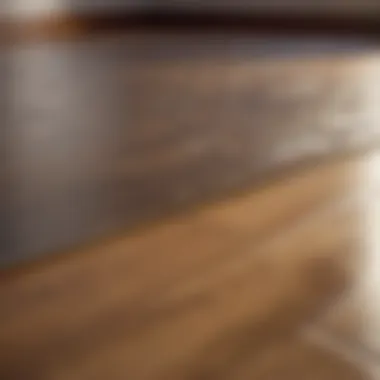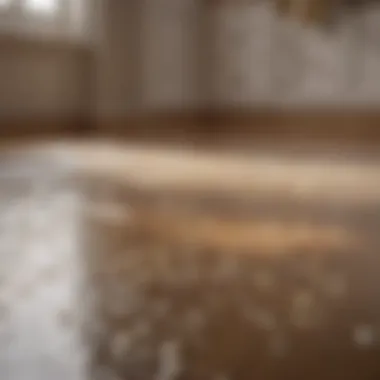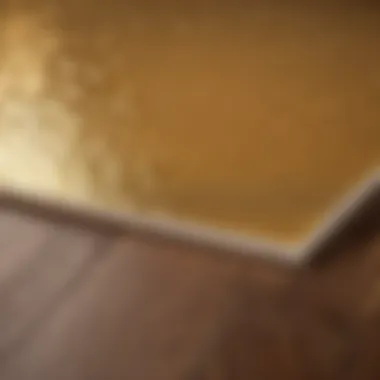Materials:
- High-quality laminate flooring: Ensure to purchase enough square footage for your room size, accounting for any cutting or waste.
- Underlayment: Select a suitable underlayment material, such as foam, cork, or rubber, based on your specific needs and preferences.
- Moisture barrier: Invest in a moisture barrier to prevent any water seepage and protect your laminate flooring.
- Tape measure: Accurately measure the dimensions of your room for proper flooring installation.
- Utility knife: Use a sharp utility knife for precise cutting during the installation process.
- Spacers: Utilize spacers to maintain consistent and even gaps between the flooring and the walls.
- Tapping block and hammer: These tools will help secure the flooring planks tightly together.
DIY Steps:
- Measure the Room: Begin by measuring the length and width of your room to determine the amount of laminate flooring needed.
- Prepare Subfloor: Ensure the subfloor is clean, level, and free of any debris before installing the underlayment.
- Install Underlayment: Carefully lay the underlayment material according to the manufacturer's instructions, ensuring proper coverage.
- Lay Moisture Barrier: Place the moisture barrier over the underlayment, overlapping the edges and sealing any seams securely.
- Acclimate Flooring: Allow the laminate flooring to acclimate in the room for recommended time before installation.
- Start Installation: Begin laying the flooring, ensuring the tongue-and-groove connections fit snugly together.
Technical Aspects:
- Tools: Utilize tools such as a table saw for accurate cuts, a pull bar for tight fittings, and a rubber mallet for gentle tapping.
- Timing: Plan for sufficient time to complete the installation process without rushing, ensuring meticulous attention to detail.
- Techniques: Employ proper techniques such as staggering the seams, maintaining expansion gaps, and ensuring proper alignment.
DIY Project Process:


- Sequential Steps: Follow a step-by-step process of installing the laminate flooring, taking care to maintain consistency and precision throughout.
- Troubleshooting Tips: In case of any issues, use additional spacers, adjust the plank alignment, or utilize extra tapping force when needed for a seamless finish.
Introduction


Understanding the Significance of Subfloors
Impact on Laminate Flooring Performance
The impact of the subfloor on laminate flooring performance cannot be underestimated. A well-prepared and suitable subfloor can enhance the stability and durability of the laminate flooring. One key characteristic of subfloors is their ability to provide a level surface, which is essential for preventing issues such as buckling and uneven wear in the laminate flooring. The unique feature of subfloors lies in their capacity to absorb minor imperfections, ensuring a flawless appearance for the laminate flooring. Properly preparing the subfloor can significantly contribute to the overall integrity of the flooring, making it a popular and beneficial choice for those looking to achieve a professional finish.
Importance of Proper Installation
Proper installation of the subfloor is equally important in ensuring the success of laminate flooring. The subfloor must be correctly installed to avoid problems such as shifting or squeaking in the flooring later on. One key characteristic of proper installation is ensuring that the subfloor is clean, dry, and free of any debris that could affect the laminate flooring. The unique feature of proper installation is its ability to create a solid foundation for the flooring, reducing the likelihood of issues arising over time. By following the correct installation process, you can maximize the lifespan and performance of your laminate flooring, making proper installation a crucial aspect to consider.
Factors Influencing Underlayment Choice
Moisture Resistance
Moisture resistance is a critical aspect to consider when selecting underlayment for laminate flooring. Choosing underlayment with high moisture resistance helps protect the flooring from potential water damage, which can compromise its integrity. The key characteristic of moisture resistance in underlayment is its ability to create a barrier that shields the laminate flooring from moisture infiltration, preserving its appearance and structural strength. This unique feature ensures that the flooring remains in top condition even in high-humidity environments, making underlayment with excellent moisture resistance a popular and advantageous choice for long-lasting flooring installations.
Sound Absorption
Sound absorption is another essential factor to consider in underlayment selection for laminate flooring. Opting for underlayment with superior sound absorption properties helps reduce noise transmission, creating a quieter and more peaceful indoor environment. The key characteristic of sound absorption in underlayment lies in its ability to dampen impact noise, such as footsteps and moving furniture, improving the acoustic comfort of the space. This unique feature adds value to the underlayment by enhancing the overall living experience and making it a preferable choice for homeowners seeking a quieter ambiance.
Thermal Insulation
Thermal insulation is a key consideration when choosing underlayment for laminate flooring, especially in regions with fluctuating temperatures. Selecting underlayment with good thermal insulation properties helps regulate the indoor temperature, providing a comfortable living environment throughout the year. The key characteristic of thermal insulation in underlayment is its ability to resist heat transfer, helping maintain consistent warmth underfoot. This unique feature contributes to energy efficiency and can lead to cost savings in heating expenses, making underlayment with effective thermal insulation a popular and sensible choice for homeowners prioritizing comfort and sustainability.
Leveling Requirements
Leveling requirements are an important factor to address during the underlayment selection process for laminate flooring. Ensuring that the subfloor is properly leveled before installing the underlayment is crucial for achieving a smooth and uniform surface for the flooring. The key characteristic of leveling requirements in underlayment is their capacity to compensate for irregularities in the subfloor, preventing issues such as creaking or uneven appearance in the laminate flooring. This unique feature allows for a flawless finish, enhancing the overall aesthetics and functionality of the flooring. By adhering to specific leveling requirements, you can ensure a professional installation that aligns with industry standards, making it a beneficial and practical choice for a seamless flooring experience.
Types of Underlayment


Types of underlayment play a critical role in enhancing the quality and longevity of laminate flooring installations. Ensuring the correct type of underlayment is selected is essential for a successful flooring project. By carefully considering factors such as moisture resistance, sound absorption, thermal insulation, and leveling requirements, one can determine the most suitable underlayment for the specific flooring needs.
Foam Underlayment
Properties
Foam underlayment stands out for its exceptional properties that contribute significantly to optimizing laminate flooring installations. The key characteristics of foam underlayment include its lightweight structure, cushioning effect, and ability to reduce noise transmission. These properties make foam underlayment a popular choice for its ease of installation and ability to improve underfoot comfort. The unique feature of foam underlayment lies in its sound-absorbing capabilities, creating a quieter and more comfortable indoor environment. However, one potential disadvantage is that certain foam underlayments may lack durability when exposed to heavy foot traffic or moisture, requiring careful consideration during selection.
Suitability for Laminate Flooring
The suitability of foam underlayment for laminate flooring is evident in its compatibility with the floating floor installation method commonly used with laminate planks. The key characteristic of foam underlayment that makes it an ideal choice for laminate flooring is its ability to provide a stable and comfortable base for the flooring material. The unique feature of foam underlayment lies in its ability to smooth out minor subfloor imperfections, enhancing the overall finish of the laminate flooring. While offering benefits such as thermal insulation and noise reduction, foam underlayment may have limitations in terms of moisture resistance and durability under specific conditions.
Cork Underlayment
Benefits
Cork underlayment offers a range of benefits that contribute to the excellence of laminate flooring installations. The key characteristic of cork underlayment includes its natural resilience and ability to provide thermal insulation. This benefit makes cork underlayment a popular choice for those seeking environmentally friendly options that enhance the overall comfort of living spaces. The unique feature of cork underlayment lies in its hypoallergenic properties, which can improve indoor air quality by inhibiting mold and mildew growth. However, one consideration in using cork underlayment is its susceptibility to indentation from heavy furniture or foot traffic, requiring cautious evaluation for high-traffic areas.
Installation Considerations
When considering cork underlayment for laminate flooring, installation considerations play a crucial role in achieving optimal results. The key characteristic of cork underlayment installation lies in its simplicity and suitability for DIY projects due to its lightweight nature. The unique feature of cork underlayment installation is its ability to act as a natural moisture barrier, protecting the laminate flooring above. While offering benefits such as acoustic insulation and sustainability, cork underlayment installation may require additional care during handling to prevent damage or inconsistencies in the final flooring finish.
Rubber Underlayment
Durability
The durability of rubber underlayment significantly enhances the performance and longevity of laminate flooring installations. The key characteristic of rubber underlayment is its robust structure and resistance to wear and tear. This durability makes rubber underlayment a popular choice for areas with high foot traffic, ensuring a stable and long-lasting flooring foundation. The unique feature of rubber underlayment lies in its ability to reduce impact sound, creating a quieter and more comfortable interior environment. However, one consideration with rubber underlayment is its potential for off-gassing odors when newly installed, necessitating proper ventilation during and after installation.
Noise Reduction
Noise reduction is a crucial aspect of rubber underlayment that significantly contributes to the overall quality of laminate flooring installations. The key characteristic of noise reduction in rubber underlayment is its ability to absorb impact and airborne sounds, reducing noise transmission between floors. This noise reduction feature makes rubber underlayment an ideal choice for apartments or multi-story buildings where noise control is essential. The unique feature of noise reduction in rubber underlayment lies in its dense composition, which effectively dampens sound vibrations, enhancing the acoustic comfort of living spaces. However, one consideration in using rubber underlayment for noise reduction is its potential for compression over time, impacting its long-term effectiveness.
Combination Underlayment
Features
Combination underlayment presents a versatile solution that incorporates various features to optimize laminate flooring installations. The key characteristic of combination underlayment includes its multi-layer composition, combining properties such as moisture resistance, sound absorption, and thermal insulation in a single product. This versatility makes combination underlayment a convenient choice for those seeking a comprehensive underlayment solution that addresses multiple flooring requirements. The unique feature of combination underlayment lies in its ability to minimize subfloor imperfections while providing additional benefits such as improved energy efficiency and acoustic performance. However, one consideration with combination underlayment is its cost, which may be higher than individual underlayment options, requiring a balanced assessment of benefits and budget considerations.
Pros and Cons
Understanding the pros and cons of combination underlayment is essential in making informed decisions for laminate flooring installations. The key characteristic of the pros of combination underlayment lies in its all-in-one functionality, simplifying the installation process and reducing the need for multiple underlayment layers. This advantage makes combination underlayment a time-saving and cost-effective choice for flooring projects. However, one potential downside of combination underlayment is the risk of over-engineering, where certain features may not be necessary for specific flooring applications, leading to unnecessary expenses. By carefully evaluating the pros and cons of combination underlayment, one can determine its suitability for achieving an optimal balance between performance and practicality in laminate flooring installations.
Installation and Maintenance
In the realm of laminate flooring installation and maintenance, precision and expertise are paramount to achieving a flawless end result. This article elevates the significance of proper installation and meticulous upkeep to ensure the longevity and quality of your flooring investment. By understanding the specific elements and benefits associated with installation and maintenance, homeowners can safeguard their floors from wear and tear, and maintain a pristine aesthetic within their living spaces.
Proper Installation Techniques
Preparation Steps
Preparation steps play a crucial role in the overall success of laminate flooring installation. These initial actions serve as the foundation for a seamless process and a durable outcome. The key characteristic of preparation steps lies in their ability to create a level and stable surface for the flooring material to rest upon. By meticulously following these steps, homeowners can mitigate the risk of issues such as shifting or uneven flooring over time. The unique feature of preparation steps is their versatility and applicability to various subfloor types, making them a popular choice for ensuring the structural integrity of the installation. While preparation steps involve additional time and effort, their advantages in providing a sturdy base for laminate flooring far outweigh any potential disadvantages, resulting in a superior end result.
Installation Instructions
When it comes to installation instructions for laminate flooring, attention to detail is key. Proper installation techniques not only guarantee a visually appealing outcome but also contribute to the overall durability and functionality of the flooring. The key characteristic of installation instructions lies in their sequential nature, guiding homeowners through each step of the installation process with precision. By following these instructions meticulously, individuals can avoid common pitfalls and errors, ensuring a professional-looking finish that can withstand daily wear and tear. The unique feature of installation instructions is their ability to empower homeowners with the knowledge and skills needed to complete the installation successfully. While adhering to installation instructions may require patience and careful execution, the benefits of a well-installed laminate floor in terms of longevity and aesthetic appeal make it a worthwhile endeavor.
Maintenance Guidelines
Cleaning Methods
Effective cleaning methods are essential for preserving the beauty and integrity of laminate flooring over time. By highlighting the key characteristic of cleaning methods, which is their ability to remove dirt and debris without causing damage to the flooring surface, homeowners can maintain a hygienic environment while prolonging the lifespan of their floors. The unique feature of cleaning methods is their versatility, as they can be adapted to different types of laminate flooring finishes and textures. While cleaning methods may require regular upkeep, their advantages in preserving the floor's appearance and structural integrity make them a crucial aspect of maintenance.
Repair Tips
Inevitably, laminate flooring may require occasional repairs to address minor damages or imperfections. Repair tips serve as a practical solution for homeowners looking to restore the beauty and functionality of their floors. The key characteristic of repair tips lies in their ability to rectify issues such as scratches, dents, or chipped edges, seamlessly blending the repaired areas with the rest of the flooring. The unique feature of repair tips is their cost-effectiveness and ease of implementation, allowing homeowners to maintain their floors without extensive renovation costs. While mastering repair tips may involve some trial and error, the benefits of being able to extend the lifespan of laminate flooring and retain its visual appeal justify the learning curve associated with these maintenance techniques.
Conclusion
Optimizing Subfloor Selection
Key Takeaways
Delving into the realm of key takeaways regarding subfloor selection for laminate flooring installations, it becomes apparent that this pivotal aspect carries immense weight in the overall outcome. Key takeaways serve as compact yet profound nuggets of wisdom, distilling complex information into actionable insights for readers. The key characteristic of these takeaways lies in their ability to streamline decision-making processes, enabling homeowners to navigate through the myriad of options with clarity and purpose. In this article, key takeaways stand out as a valuable resource, offering a concise summary of crucial factors to consider, such as moisture resistance, sound absorption, thermal insulation, and leveling requirements.
Considering their utility, key takeaways prove to be a beneficial choice for readers, providing a quick reference guide that enhances understanding and facilitates informed decision-making. Their unique feature lies in their ability to encapsulate essential information concisely, making them time-efficient and practical for individuals embarking on laminate flooring projects. While key takeaways offer significant advantages in streamlining the decision process, it is essential for readers to supplement this information with additional research to address specific needs and preferences.
Ensuring Longevity of Laminate Flooring
When exploring the essential aspect of ensuring the longevity of laminate flooring, a critical focus emerges on sustainable durability and performance over time. This particular facet contributes substantially to the overall objective of achieving a lasting and flawless finish for your floors. The key characteristic of longevity lies in its ability to enhance the lifespan of laminate flooring, safeguarding against wear and tear, moisture damage, and other factors that could compromise its integrity.
Ensuring the longevity of laminate flooring proves to be a popular choice for homeowners seeking investments with lasting value and minimal maintenance requirements. Its unique feature resides in the balance it strikes between resilience and aesthetics, offering a durable solution without compromising on visual appeal. While the advantages of longevity are clear in terms of cost-effectiveness and reduced downtime for repairs, potential disadvantages may include the initial investment for top-quality materials and labor. Overall, in the context of this article, longevity plays a crucial role in emphasizing the importance of durable subfloor selections and meticulous maintenance practices for long-term satisfaction and enjoyment of laminate flooring.





